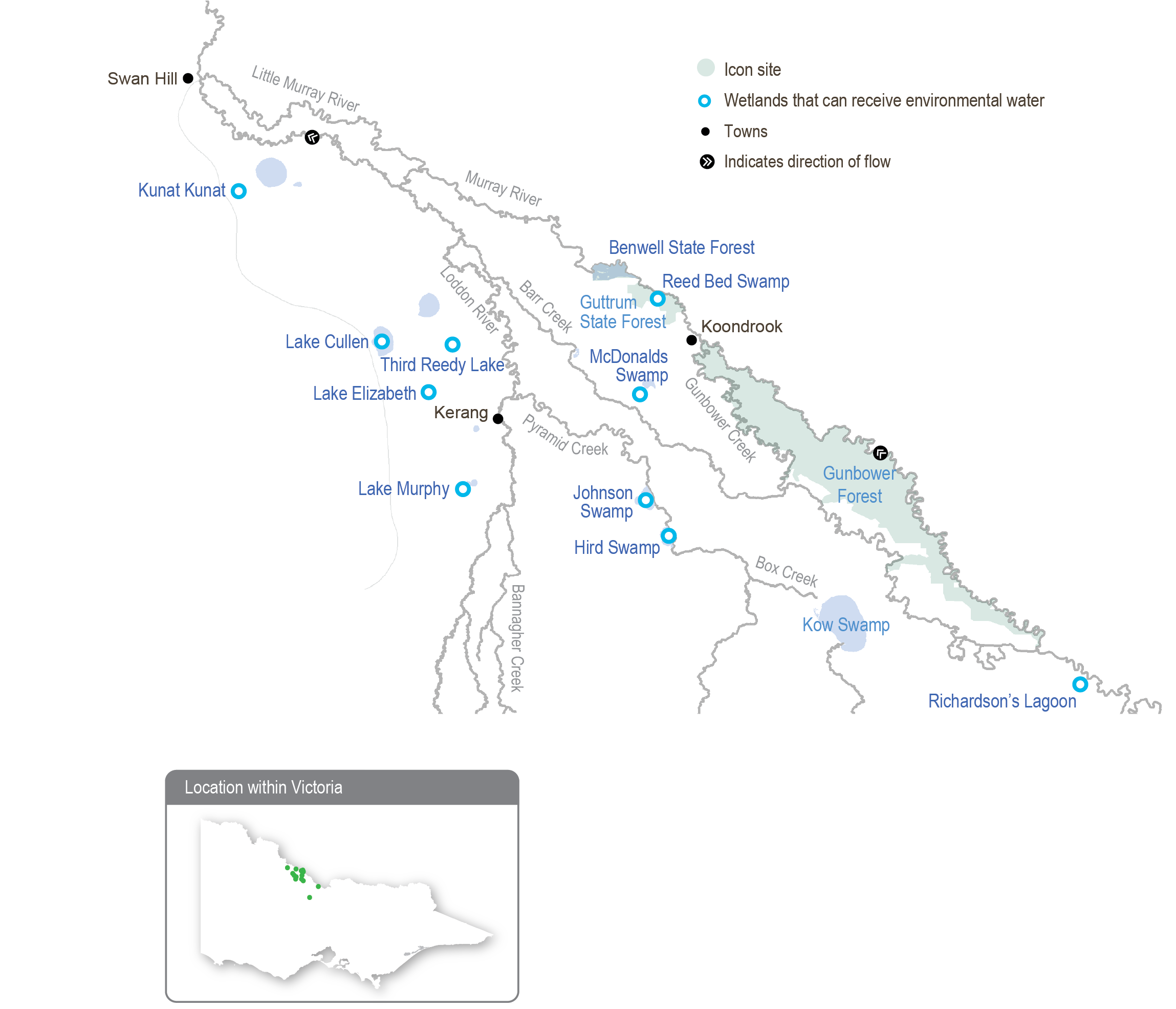On this page:
Latest information about where, when and why environmental water may be delivered to the central Murray wetlands and the environmental objectives being targeted is available in this year’s seasonal watering plan.
The seasonal watering plan also contains information about how environmental flows could support cultural, social, recreational and economic values in the central Murray wetlands.
Watering data for the central Murray wetlands and the wider northern region is updated quarterly. Visit current watering releases to find out more.
To find out the current environmental water entitlements held by the VEWH in the central Murray wetlands visit our water holdings.
Information about the ownership of water entitlements in the central Murray wetlands can be found under the Entitlements and Compliance section of the Murray basin page at Victorian Water Accounts.
The central Murray wetlands are part of the Victorian Murray system.
Traditional Owners
Wamba Wemba Aboriginal Corporation (WWAC) and Yorta Yorta Nation Aboriginal Corporation are Registered Aboriginal Parties under the Victorian Aboriginal Heritage Act 2006 and have statutory authority for the management of Aboriginal heritage values and culture, under the Victorian Aboriginal Heritage Act 2006.
The Barapa Barapa people also have connections to the central Murray wetlands region.
Yorta Yorta Nation Aboriginal Corporation (YYNAC) also has a Traditional Owner Land Management Agreement to jointly manage Barmah National Park.
System overview
The central Murray wetlands are located on the lower Loddon River and Murray River floodplains. The wetland system includes Guttrum state forest, Hird Swamp, Johnson Swamp, Kunat Kunat (Round Lake), Lake Cullen, Lake Elizabeth, Lake Murphy, McDonalds Swamp, Richardson Lagoon and Third Reedy Lake. Muringa wetlands and the Wirra-lo wetland complex have previously received water for the environment, but these wetlands are on private land, and those landowners are currently managing their water regimes. Therefore, they are not included in this year’s seasonal watering plan.
The central Murray wetlands are almost wholly contained within the Torrumbarry Irrigation Area and are all wetlands of regional or international significance. The area has experienced dramatic changes since European settlement with the construction of levees, roads and channels. Most of the wetlands are now cut off from natural flow paths and are rarely filled, except by large natural floods. They rely on water for the environment to support their ecological character and health.
Nine of the central Murray wetlands can receive water for the environment from permanent infrastructure: Hird Swamp, Johnson Swamp, Kunat Kunat, Lake Cullen, Lake Elizabeth, Lake Murphy, McDonalds Swamp, Richardson’s Lagoon and Third Reedy Lake. Temporary pumps are currently used to deliver water for the environment from the Murray River to Reed Bed Swamp in Guttrum Forest when required. More permanent water delivery infrastructure for Guttrum Forest is proposed as part of the Victorian Murray Floodplain Restoration Project.
Environmental values
The central Murray wetlands support numerous listed threatened species ranging from vulnerable to critically endangered, including the Australasian bittern, Murray hardyhead, Australian painted snipe, growling grass frog and the southern purple spotted gudgeon, which was presumed extinct in Victoria until it was found at Third Reedy Lake in spring 2019.
When the wetlands receive environmental water, they can attract prolific birdlife and provide feeding and breeding habitat for many threatened and endangered bird species (including the eastern great egret and white-bellied sea eagle) listed under legislation and international agreements. Lake Cullen, Hird Swamp, Third Reedy Lake and Johnson Swamp are internationally recognised under the Ramsar Convention, while the other wetlands in the central Murray system have bioregional significance.
Page last updated: 29/07/25
